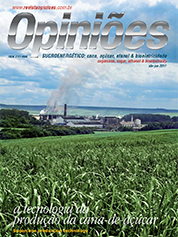Fernando José Prati
Corporate Agriculture Manager at Grupo Toniello
Op-AA-28
In a countertrend, but allied with technique
The sugar and ethanol industry underwent far-reaching change in the last decade. World society demands the search for new energy sources that have to be renewable and less polluting than current ones, and on account of this scenario, ethanol appeared as a great market alternative.
With the increase in competitiveness and large foreign capital investments, the quest for new technologies providing productivity increases acquired fundamental importance. Soil, until then treated merely as substratum, given that in the view of some people, “sugarcane supports all abuse”, started to be viewed as an important factor for increasing productivity, provided it is better exploited and cared for during its preparation.
In recent times, with the cost reduction rage in progress, expenses with soil preparation decreased considerably, with minimal plantings, while increasingly ignoring the consequences this could bring about. A simple Excel spreadsheet replaced all technical analyses. Truly, technological assassination.
By all means, what we cannot do is to confound cost reduction with investment reduction. A friend of mine, Fernando Prati, states “it is possible to earn more while spending more”. This is easy to explain. Let us make an analogy. Our children, in order to grow strong and healthy, need good food, balanced and healthy.
If they stop taking vitamins, proteins, carbohydrates, etc., they will grow to be rachitic and will be much more susceptible to diseases, with a shorter life expectation. Consequently, one will have spent more on feeding and educating one’s child, but less on medical drugs and hospitals and the child will be healthy longer.
The same is true for sugarcane. If one neglects correcting the soil, or uses a small area for root expansion, or if one does not decompress the soil, etc., one’s sugar-cane will grow to a shallow depth and have a short life, (short ratoon longevity), thus resulting in an increase of end costs, for the sake of an apparent and momentary reduction in soil preparation.
Bearing this in mind, I wish to convey our experience in soil preparation for sugarcane agriculture, which already is a 15-year old success story and is the fundamental part of our “Vertical Growth Program”, implemented in companies of the Toniello Group, which allowed us to go from a productivity of 87 tons/ha in 1995, to 105 tons/ha in 2010.
Our main objectives concerning soil preparation aim at higher ratoon longevity, to warrant an ideal standard (no errors) in the cuttings (mainly because of the aggressiveness of mechanical cutting), assuring higher resistance in dry periods, due to deeper root expansion, while increasing the available plant nutrition area, and hence, productivity.
We begin with a highly representative soil analysis of the area, done in two layers, of between 0 and 25 and 25 to 50 centimeters depth, with the objective of “creating” a root exploration area of 50 cm, totally prepared and ready for the plant.
Once we know the result, we correct the soil through liming, and by applying gypsum and phosphates, as required. These products are homogenized by harrowing and incorporated into the ground by furrowing. We know that both phosphorus and lime spread little in the soil, and hence, if in-depth correction is wanted, we need to place them there.
At this point, one should emphasize an additional and important benefit, which is the depth of furrows. If we have soil corrected at 50 cm that allows good root development, we need not furrow deeper; 15 to 20 cm suffice, because the roots will search for nutrients and water in depth, allowing for a robust ratoon, more resistant to mechanical blows from harvesters, and thus we will require less tractor power to furrow and to level the terrain.
After correcting the soil, we use a trowel to level the ground as best possible, correcting small protuberances and depressions. The outcome is fantastic, because it causes a major benefit for future operations, such as, furrowing (uniformity in planting), application and action of pesticides, terrain leveling, mechanical harvesting, ratoon longevity, etc.
Next we plow the ground to break any compact soil layer that might prevent proper drainage and aeration. Finally, we level the ground by furrowing, so as to plant cereal, such as soybeans, peanuts, corn, etc. After harvesting cereal, one plants sugarcane and reaps the fruit of such an investment, which will be highly worthwhile, both in terms of productivity and sugarcane plantation longevity, and hence, from a financial perspective.
Reach your conclusions and do your best, but do not abdicate from technical knowledge. For everything there is a technical explanation that directs us along a more suited path. Sugarcane can withstand abuse, but it will respond positively and generously reciprocate everything you give it in exchange.




